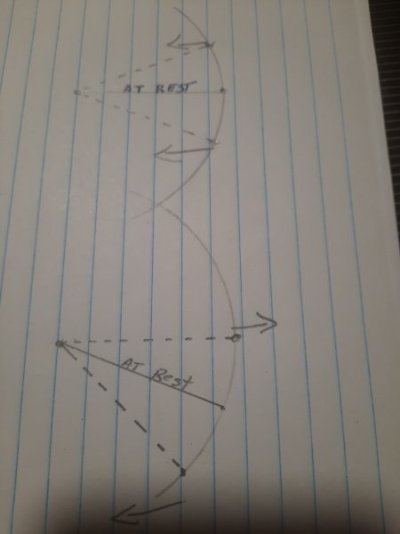I would disagree with the use of the term camber in this situation. Camber is a measurement of the wheel off perpendicular to the ground, by definition. Doesn't apply here and not what the dictionary definition refers to. Simply serves to confuse in this discussion and is inconsistent with the dictionary definitiion.
When we think about the arc the axle moves in as the spring moves, there are other factors to consider. One is that when any arm travels in an arc,how the axle moves depends on where it is in it's travel. If, at rest, the arm(front spring portion) is below horizontal, movement upward of the arm (downward of the car) will move the axle back as it approaches horizontal. However, downward movement of the arm will move the axle forward. If at rest the arm is horizontal the axle is now furthest from it's pivot, it doesn't matter which direction the arm moves, up or down, the axle will always move foreward. So that is one thing you need to determine in a discussion like this.
The relevance to that is what's happening on the other side. In a lean one side is down, the other up. If the design is of the latter type where at rest the straight line from centering pin in the spring to the eye is horizontal, the side that's low is moving the axle forward, but the other side, that's lifting, is also moving the axle forward. Result, no change in relation to the front to back centreline of the car.
Not so much on these cars because at rest the main leaf is nearly straight, is that the spring arc needs to be considered. How much the axle moves forward is a function of two things, the amount of up or down travel, and the length of the radius. In the context of this discussionsions, whether it's GM, Ford, Mopar, the length of the spring behind the axle is unimportant. It's the distance from the fixed eye(in this case the front, but that's not always the case) to the axle centering bolt. The back half is along for the ride. As the arc in the spring changes through deflection the effective length of the radius changes. If it goes from an arc to a straight line, the distance increases. If it goes from a straight line to a curve, like these cars are at, the distance decreases. That does two things. Shortening the radius moves the axle forward, but it also tightens the arc that the axle travels in. Which means for the same amount of travel the axle will move forward more.
In short, this is far more complex than the oversimplified, applies to all, explanation given here. We haven't gotten into spring wrap under aceleration and it's affect on the geometry. Are you into the throttle or braking. But to put this into perspective, this is hardly a topic that applies to 99.99% of the membership here, and certainly not one that a member should take attitude with another over their lack of knowledge on the subject.
BTW, the axles on most cars with leaf springs or front to back trailing arms (c2/c3 Corvette) will move forward when hanging.


















